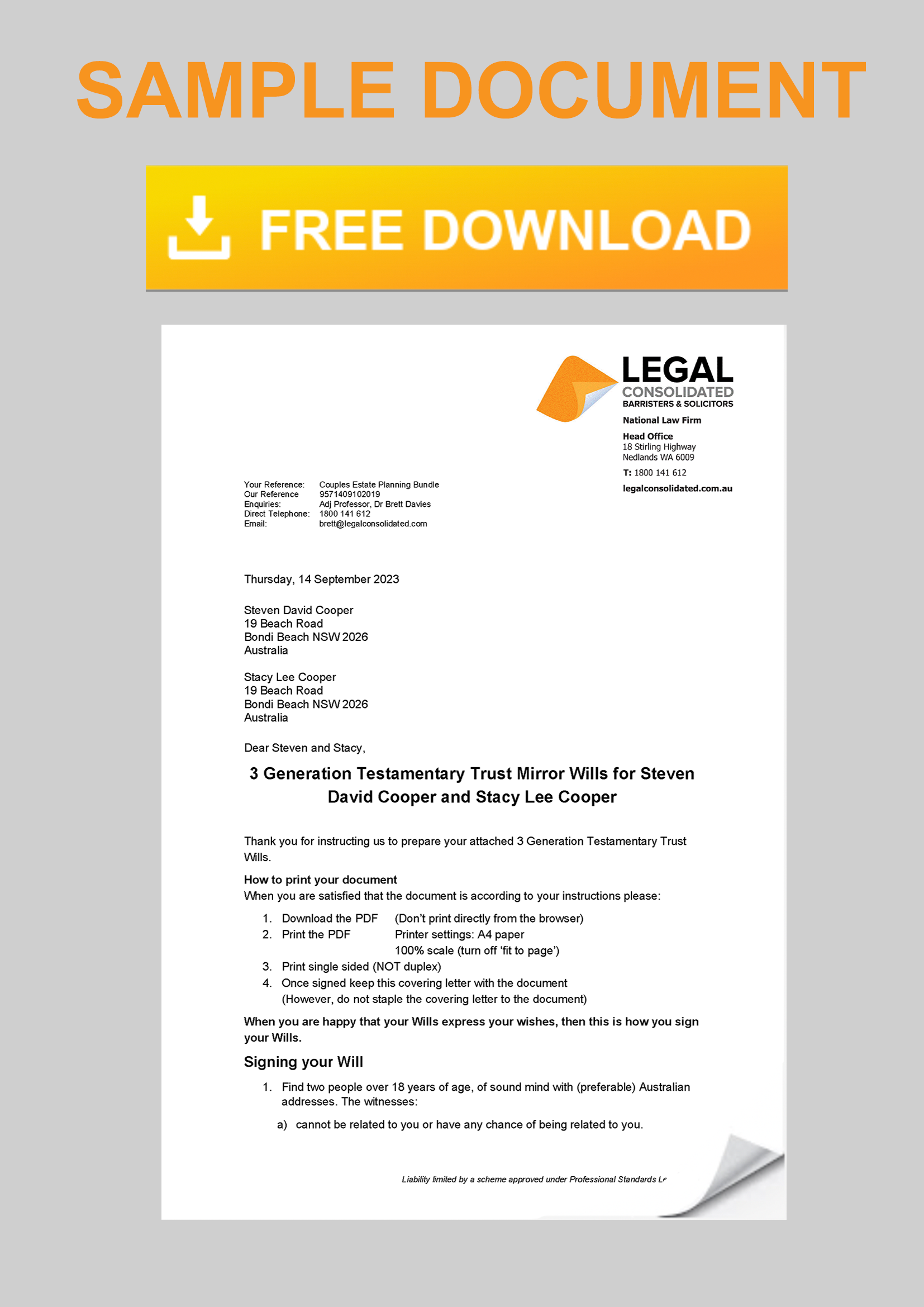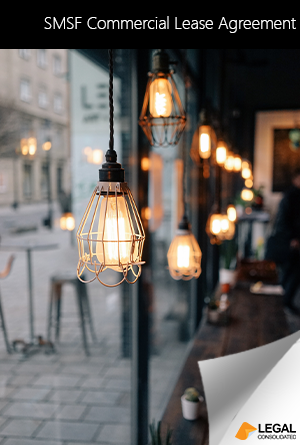
SMSF Commercial Lease Agreement
$645 includes GST
-
- Build online in 14 minutes.
- Our free building process guides you every step of the way.
- Fully complies with SMSF laws.
Legally Compliant SMSF Commercial Lease: Audit-Ready & Built in 14 Minutes
Designed by Adjunct Professor Dr Brett Davies, Leading SMSF Barrister & Solicitor
Using your Self-Managed Super Fund (SMSF) to lease your business premises is a powerful strategy. However, the Australian Taxation Office (ATO) imposes a strict and complex legal framework. A standard commercial lease is dangerously inadequate and leads to severe penalties.
Our law firm’s lease is built to provide you with a compliant, audit-ready safeguard for your retirement savings, meticulously drafted to comply with Commonwealth superannuation law.
✅ ATO & SIS Act Compliant: Specifically designed to comply with the Superannuation Industry (Supervision) Act 1993 (SIS Act) and its regulations.
✅ Avoids the 45% NALI Tax Trap: Ensures your lease is on an ‘arm’s length’ basis to protect your fund from the punitive non-arm’s length income (NALI) rules under s295-550 of the Income Tax Assessment Act 1997.
✅ Audit-Ready: Provides the clear, legally enforceable paper trail your SMSF auditor requires to verify compliance every year.
✅ Legally Enforceable: Drafted by our Australian law firm to be a robust, legally binding agreement, giving you certainty and protection.
The High Cost of a Non-Compliant Commercial Lease
Failing to meet the ATO’s strict requirements or act at arm’s length leads to:
-
45% Tax on All Income: All rental income and capital gains from the property are taxed at the highest marginal rate under the NALI rules.
-
Trustee Fines & Disqualification: The ATO imposes personal fines on you as the trustee and disqualifies you from acting as an SMSF trustee or director of an SMSF corporate trustee.
-
SMSF Deemed Non-Complying: In serious cases, your entire SMSF loses its complying status and a penalty tax is levied on the entire value of the SMSF.
-
Forced Sale of the Property: Your fund is directed by the regulator to dispose of the property to rectify a breach.
Our Legal Consolidated SMSF Commercial Lease is your compliance safeguard. Built by our law firm and designed specifically to navigate the complexities of the SIS Act and Tax Act, it provides the legal certainty and peace of mind you need.
Our Leases Ensure Full Compliance with all 8 Key ATO Requirements
The primary risk for an SMSF leasing commercial property is failing an ATO audit. Our lawyer-drafted leases are specifically designed to provide the evidence and paper trail your SMSF auditor needs to see. We transform these complex rules from a risk into a feature of our document, ensuring every requirement is met :
- Prepared by a Specialist Lawyer Your lease is drafted and signed off by our Australian law firm, ensuring professional accountability and satisfying the first rule of compliance.
- Enforces an ‘Arm’s Length Transaction’ The terms are commercially sound, with no special treatment or ‘mates rates’ for the tenant. This is fundamental to proving the lease is for the sole purpose of benefiting the SMSF in retirement.
- Evidence of Market Rent The agreement includes provisions for charging and reviewing rent at fair market value, with a clear mechanism to prove it to your auditor.
- Legally Binding Payment Terms We establish legally enforceable due dates for rent payments, creating a clear commercial obligation for the tenant.
- Strict Breach and Remedy Clauses The lease outlines the formal actions the SMSF must take to remedy any breach (e.g., late payment), as required by the ATO to demonstrate proper fund governance.
- Creates an Auditor-Ready Paper Trail The document itself is the necessary evidence to prove to your SMSF auditor and the ATO that no illegal early access to super or advantage has been given to a member.
- Full Legal & Superannuation Law Compliance The agreement adheres to both the Superannuation Industry (Supervision) Act 1993 and relevant state-based Commercial Tenancy legislation.
- Allows prepayment of rent There is an express power for the tenant to prepay rent under the Lease Agreement
How the free building process works: A Simple, Secure, and Educational Process
Our online platform is designed to educate you as you build your document. By answering the questions, you learn about the critical information required for a compliant SMSF lease.
- Start for Free & Learn as You Go Answer our straightforward questions online. Our system uses your answers to construct the lease, explaining key terms and concepts as you progress. We save your progress every time you move to the next question.
- Approve and Finalise You receive the final, lawyer-approved SMSF Commercial Lease Agreement. Only at this final step is payment required. You get a legally binding document and the letter of advice on our law firm’s letterhead.
Frequently Asked Questions for SMSF leasing commercial property
-
Why cannot I use a standard commercial lease from a real estate agent? A standard lease does not contain the specific clauses required under the SIS Act. It won’t address the ‘arm’s length’ rules or provide the necessary evidence for an SMSF auditor, putting your fund at significant risk of non-compliance.
-
What happens if I do not have a compliant lease? The ATO can declare the lease an ‘in-house asset’. This can lead to significant penalties, including forcing the sale of the property and potentially deeming the fund non-compliant, which has major tax consequences.
-
Does this lease work for all of Australia? Yes. Our lease is drafted to comply with the federal SIS Act and includes the necessary clauses for individual Commercial Tenancy legislation in Australian states and territories.
-
Can I update the lease later? Yes. Uniquely, the lease contains provisions for rent reviews and other variations, including via an exchange of emails. If you need to make a significant change, you can build a Deed of Variation of Lease on our website or build a new lease.
About Legal Consolidated Barristers & Solicitors’ superannuation practice
Since 1988, we have been a trusted Australian law firm dedicated to providing accessible, compliant, and strategic SMSF legal documents. Our team consists of specialist lawyers and tax professionals who are experts in their fields. Unlike a template website, we are a fully regulated law firm. Every document you build is backed by our legal expertise and professional indemnity insurance, giving you unparalleled peace of mind. We provide documents to over 3,800 financial planners, lawyers, accountants and clients across Australia.
Ready to Protect Your SMSF?
Take the first step towards securing your fund’s compliance. Start building your draft lease now—it’s free to begin, and there is no obligation.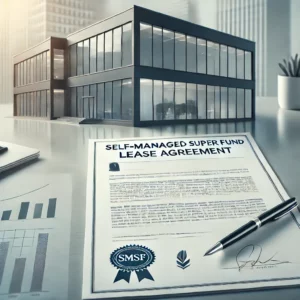
SMSF Commercial Lease fails ATO scrutiny
An accountant shows me a non-complying, self-managed super fund that owns commercial property. The problem? The SMSF does not have a legally drafted commercial lease. Although the lease complied with the law, it did not address the requirements of the SIS legislation and failed the ATO audit.
Your SMSF Commercial Lease Agreement must comply with both the state laws and the Commonwealth Superannuation law. If your SMSF is non-compliant, the ATO applies penalties and additional taxes.
SMSFs require specialist leases. The commercial lease should be subservient to the Superannuation rules. It is not enough to use a standard commercial lease. Legal Consolidated’s SMSF commercial lease complies with the SIS Legislation.
What happens when the SMSF leases to a non-related party?
Our SMSF Commercial Lease is designed for SMSFs. However, if your SMSF is leasing the commercial property to a non-related party, the Lease must still comply with the SIS Legislation.
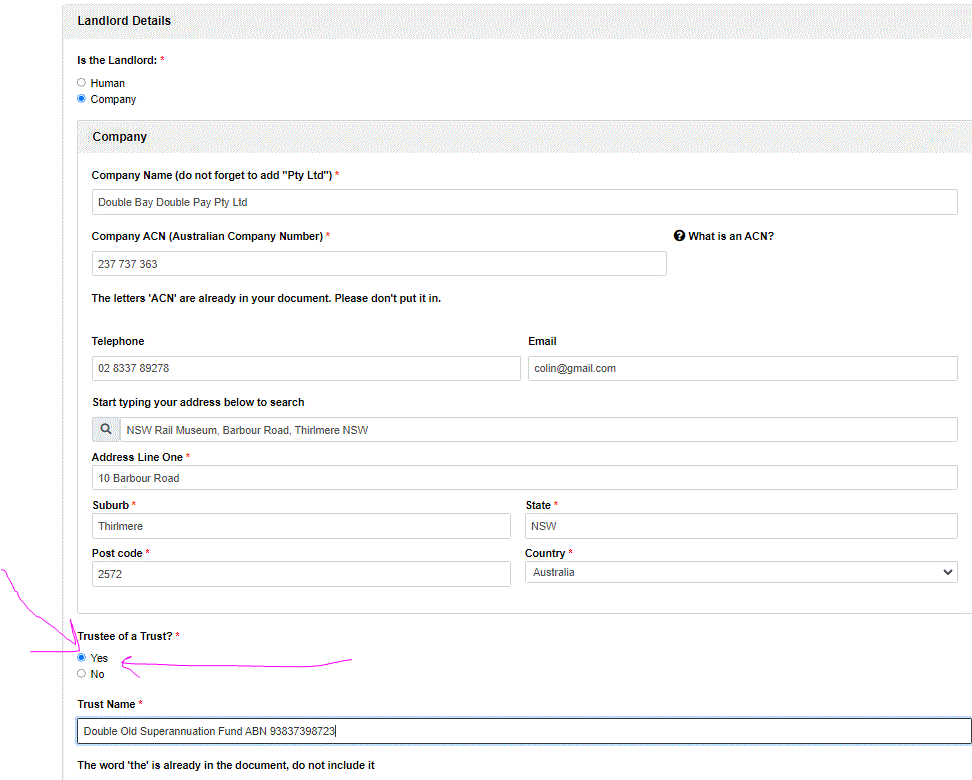
The SMSF has a company as the trustee. The company is the Landlord. Select Yes to Trustee of a Trust. Type in the name of the SMSF and its ABN.
Extra issues when leasing Commercial Property to a member of the SMSF
There are additional challenges when leasing to a member. For example:
1. Member gains an advantage from the SMSF. For example, the rent charged by the SMSF is too low. A member illegally gains an advantage.
2. The member gives an advantage to the SMSF. For example, the rent is too high, so the member illegally injects funds into the SMSF. This is a contribution by the member or a ‘related person’.
SMSF ‘Related people’ include:
- members
- associates of members
- relatives of members
- business partners and their spouses and children
- trusts controlled by members or associates
- companies controlled by members or associates
The ATO watches ‘related party’ transactions closely.
Therefore, the lease between the SMSF and the member must be at arm’s length. The SMSF cannot give ‘special treatment’ to a related party in the commercial lease. The trustee cannot give ‘favours’ to the leasing member.
You must have:
1. a legally prepared and legally enforceable written lease agreement – designed for the SIS legislation
2. rent paid on time as required by the Commercial Lease Agreement
3. the SMSF taking appropriate action to remedy breaches
There are many SMSF rules in leasing. Legal Consolidated follows them
Our firm’s Commercial Lease Agreement complies with up-to-date Superannuation law, including:
* Superannuation Industry (Supervision) Act 1993
* Superannuation Legislation (Consequential Amendments and Transitional Provisions) Act 2011
* Superannuation (Financial Assistance funding) Levy Act 1993
* Superannuation (Resolution of Complaints) Act 1993
* Superannuation (Rolled-Over Benefits) Levy Act 1993
* Superannuation Industry (Supervision) Consequential Amendments Act 1993
* Superannuation Supervisory Levy Amendment Act 1993
* Occupational Superannuation Standards Amendment Act 1993
* Superannuation Act 2005
* Superannuation Act 1990
* Superannuation Act 1976
* Superannuation (Productivity Benefit) Act 1998
* Superannuation Benefits (Supervisory Mechanisms) Act 1990
* Superannuation (Family Law – Superannuation Act 1922) Orders 2004
* Superannuation (Family Law – Superannuation Act 1976) Orders 2004
* Superannuation Guarantee (Administration) Act 1992
* Superannuation Industry (Supervision) Regulations 1994
SMSF auditors require a copy of the lease before signing the yearly audit.
Our law firm’s SMSF commercial lease complies with the Superannuation laws, enhancing regulatory adherence. We also make the auditor and ATO auditor happy (well, as much as they can be).
Our SMSF Commercial Leases Follow Every Law – and Keep Your Auditor Happy
When your Self-Managed Super Fund leases property – especially to a related party – the law is strict. A poorly drafted lease can trigger breaches, tax penalties, or even SMSF disqualification.
Legal Consolidated’s SMSF Commercial Lease Agreements are built by Australian lawyers to comply with every relevant law. We follow the Acts and sections that the Australian Taxation Office and your SMSF auditor check first.
SMSF compliance rules:
1. Superannuation Industry (Supervision) Act 1993 (SIS Act) The main law controlling SMSFs. Our leases comply with:
-
-
Section 62 – Sole Purpose Test – lease must solely benefit members’ retirement savings.
-
Section 65 – prohibits giving financial assistance to members.
-
Section 66 – limits buying assets from related parties.
-
Section 71 – defines in-house assets to avoid.
-
Section 109 – requires all leases to be on arm’s-length terms.
-
2. Superannuation Industry (Supervision) Regulations 1994 Contains the technical rules that SMSF auditors check:
-
- Regulation 13.18AA – only business real property can be leased to a related party.
-
Regulation 8.02B – all rent must be supported by market valuation evidence.
3. Income Tax Assessment Act 1997 – Non-Arm’s-Length Income (NALI)
-
- If the lease terms are too generous to a related party, the rent may be taxed at 45% – even if the fund is in pension phase.
-
Our leases prevent this risk by locking in arm’s-length, market-tested terms.
- We have express powers for the Tenant to pre-pay rent (to get extra tax deductions).
4. State and Territory Property Laws
-
-
Stamp Duty Acts – Our leases are structured to avoid unintended duty liabilities.
-
Property Law / Conveyancing Acts – Ensures enforceability and compliance in your state.
-
Commercial Tenancy Acts – Keeps your SMSF in line with state-specific commercial leasing rules.
-
5. Corporations Act 2001
-
- For corporate trustees, related-party leasing must also meet corporate governance requirements.
-
Our leases meet Chapter 2E rules on related-party transactions.
What does your SMSF Auditor want to see in a Lease?
-
-
Audit-ready – Your SMSF auditor will have no reason to qualify their report.
-
ATO-compliant – Avoids fines, penalties and 45% NALI tax.
-
Peace of mind – Every term is built for SMSFs and updated for changes in the law.
-
One fixed price – We include all the clauses you need from day one.
- Update the Deed via an exchange of emails – Over the years, your accountant or SMSF Auditor will likely want to see additions or changes in your Commercial Lease. An exchange of emails can update the Legal Consolidated Lease. This saves you legal fees.
-
Special SMSF rules for lease disputes
Our SMSF Commercial Lease Agreement:
- accommodates low-cost dispute resolution alternatives. This complies with both state leasing and Commonwealth Superannuation Laws,
- reduces unconscionable conduct claims against the SMSF,
- is audit-friendly for both your auditor and the ATO.
Paying rent in advance to the Self Managed Super Fund landlord
As the end of the financial year approaches, your accountant may advise prepaying expenses, such as rent, to increase deductions and reduce your taxable income. Commonly, in arm’s-length lease agreements, tenants will approach the landlord to make advanced payments. Legal Consolidated Commercial Leases expressly allow for this. It is written into the Commercial Lease Agreement.
However, while common in arm’s-length leases, the SMSF Commercial Lease has the additional burden of needing to be both seen and actually acting on an arm’s-length basis.
A common question is whether a tenant (SMSF member) can prepay rent—sometimes up to 12 months in advance—to their SMSF Landlord. This strategy can be particularly attractive when the tenant’s personal tax rate (e.g., 47%) is significantly higher than the SMSF’s tax rate (e.g., 15%). However, all dealings must remain at arm’s length to comply with superannuation laws.
You must satisfy both your SMSF auditor and, if audited, the Australian Taxation Office (ATO). We do not give advice in this area, but your accountant will want to see that any prepayment is a legitimate, arm’s-length transaction. Your accountant would need to sign off on the forward paying of rent. While Legal Consolidated Commercial Leases expressly allow for advance payment of rent to the landlord, it does not mean that you can do so under the SMSF rules. Speak with your accountant.
Subletting commercial property in breach of the Superannuation Laws
The Tenant has no authority to sublet or assign under this Lease. This is unless the Landlord and Tenant mutually agree, subject to the Superannuation laws. The ‘waive and variation’ clause permits subletting and assignment — but is subject to the Landlord’s consent.
Fair Damages that do not breach Superannuation Contribution rules
If the Tenant (member) defaults on payment, the landlord (SMSF) recovers liquidated damages from the Tenant. It is important that this is not a ‘contribution’ to the fund. Our unique formula calculates damages that avoid ‘contribution breaches’ by the SMSF.
Without these pre-liquidated damages calculations, a commercial lease breaches the Superannuation law. Most Commercial Leases breach Superannuation laws.
Waivers ensure ongoing compliance with the SMSF Commercial Lease Agreement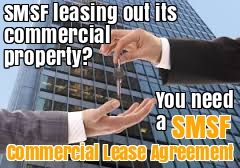
Many lease agreements cannot be updated. However, if the Superannuation laws change, then this may render your SMSF non-complying. You suffer penalties of up to half the value of your SMSF.
With our lease, the Landlord and Tenant can exchange emails to alter the Commercial Lease.
SMSF Lease vs Sublease vs Assignment of Lease
Consider a ‘sub-lease’ and an ‘assignment of lease’:
- Sub-lease: The Tenant signs a Lease. But the Tenant does not need all the space at the moment. So the Tenant tries to ‘sub-lease’ to a third person.
- Assignment of lease: Or, your tenant wants to vacate early. The tenant finds a replacement tenant. The SMSF, as the landlord, signs an Assignment of Lease.
Subleases and lease assignments are common and legal. However, when an SMSF leases commercial real property, building a brand new Commercial Lease is better.
Under the SIS regulations, sub-leases and lease Assignments may be considered too complex or confusing. The SMSF auditor may want to investigate further, ask the SMSF for more information, and get external consultants to sign off on the chain of events.
If you can, then a new SMSF Commercial Lease is simpler and safer.
Auditor and SMSF Lease
If the ‘business real property’ is leased, your auditor looks for an up-to-date:
- SMSF lease; and
- property valuation.
This is especially true if the SMSF is leasing to related parties. Ensure the lease is on an arm’s length basis. You need fair market rent. Otherwise, the SMSF is taxed at 45% on its non-arm’s length income.
The SMSF auditor for Commercial Lease reviews:
- Does the related-party tenant satisfy the terms of the lease?
- Has the related party tenant paid all the required rent and outgoings?
- Is the Lease Agreement prepared by an Australian lawyer? If not, is it an enforceable and genuine legal document? Who will check it?
- Any rent adjustments? Are they consistent with market rents?
- If the rent is indexed for inflation or some other formula, is the tenant paying this higher rent?
SMSF Property in a Custodian (Bare) Trust?
An SMSF can not borrow money because it is considered too risky. However, there are exceptions to this rule. One exception is borrowing money through a ‘Bare Trust’ (Custodian Agreement).
In a property transaction involving an SMSF and a bare trust, the landlord is typically the bare trust’s trustee, not the SMSF’s trustee. The bare trustee holds the property title and acts as the landlord until the loan is repaid and the property is transferred to the SMSF.
How to structure a Commercial Lease for a Limited Recourse Borrowing Arrangement (LRBA)
Every superannuation law firm has its own view on how a Commercial Lease is set up when a Limited Recourse Borrowing Arrangement (LRBA) is in place.
An SMSF borrows to buy a property through a bare trust called a Custodian Trust. The Custodian Trust holds the property as a bare trustee for the SMSF. The Trustee of the Custodian Trust is the ‘legal owner’ of the property. Eventually, if and when the loan is paid off, the property is transferred into the name of the Trustee of the Self-Managed Superannuation Fund.
Who should be the Landlord? The trustee of the Custodian Trust or the trustee of the SMSF?
Legal Consolidated’s Commercial Lease has the landlord as the trustee of the Custodian Trust (i.e., the trustee of the Bare Trust). In other words, the Trustee of the SMSF is not the Landlord. The Legal Consolidated SMSF Commercial Lease helps manage the eventual transfer of property to the SMSF. This is how it works:
- Initial Arrangement: During the period the property is under finance, the trustee of the Custodian Trust, as stated in Legal Consolidated’s Commercial Lease, holds the legal title and acts as the landlord.
- Automatic Transition: The commercial lease automatically transitions upon repayment of the debt on the property and when the property is transferred. Under the Legal Consolidated Commercial Lease, the landlord’s role seamlessly shifts from the Custodian Trust’s trustee to the SMSF’s trustee.
- Simplified Process: This transition in Legal Consolidated’s Commercial Lease occurs without any manual intervention or additional documentation to the Commercial Lease. It streamlines the process and helps ensure compliance with superannuation and SIS regulations.
We have found that this approach satisfies both your auditor and the regulator, the Australian Tax Office.
An auditor has argued that an SMSF Commercial Lease must always have an ‘automatic transition’ clause. Legal Consolidated SMSF Commercial Lease always do. However, we have reviewed the law and the ATO’s rulings on this, and we are of the view that while an ‘automatic transition’ clause is best practice and ‘pleases’ the ATO, it is not a mandatory requirement in an SMSF Lease.
Who is the Landlord while the property is in an SMSF Bare Trust (Custodian Trust)?
Here is an example of a Commercial Lease where the SMSF is gearing the property through a Limited Recourse Borrowing Arrangement (LRBA):
- Keller Nominees Pty Ltd is the trustee of the Keller Super Fund.
- The Keller Super Fund borrows money to fund the purchase of a commercial property.
- To allow for this, the Keller Super Fund holds the property through a non-recourse loan made through a separate company that holds the property in a bare trust.
- We will call the separate entity 238 Adelaide Terrace Pty Ltd ACN 88383763838 as trustee for the 238 Adelaide Terrace Custodian Bare Trust.
- The Keller Super Fund now wants to lease out its commercial property.
- The landlord is 238 Adelaide Terrace Pty Ltd.
- Many years later, the money is paid back. The Keller Super Fund now transfers the property to the trustee of the Keller Super Fund Keller Nominees Pty Ltd.
- Without needing to amend the Legal Commercial Lease the landlord is now Keller Nominees Pty Ltd.
If the commercial property is in a Bare Trust, the trustee of the Bare Trust (only) is the Landlord. (The Trustee of the SMSF does not become the landlord until the property is finally transferred out of the bare trust to the trustee of the SMSF.)
The SMSF Custodian Bare Trustee is the Landlord during the Limited Recourse Borrowing Arrangement (LRBA) for a Commercial Lease
Here is another example:
- The trustee of the George and Jenny Superfund is a company Black Nominees Pty Ltd.
- The George and Jenny Superfund borrow money to purchase a commercial property.
- The Super Fund does this through a Bare Trust (Custodian Trust).
- The Trustee of that Bare Trust is White Nominees Pty Ltd.
- White Nominees is the Landlord (not Black Nominees Pty Ltd).
When the happy day comes that the property is paid off, then the property is transferred to Black Nominees Pty Ltd atf the George and Jenny Superfund. The Legal Consolidated SMSF Lease automatically caters to and allows for this future event.
Full free sample of a Self-Managed Superannuation Fund Lease Agreement
Press the PDF above to see our cover letter and a sample of a Commercial Lease for an SMSF.
Business Structures when Dealing with an SMSF Commercial Lease
Family trust
- Family Trust Deed – watch the free training course
- Family Trust Updates:
- Everything – Appointor, Trustee & Deed Update
- Deed ONLY – only update the Deed for tax
- Guardian and Appointor – only update the Guardian & Appointor
- Change the Trustee – change human Trustees and Company Trustees
- The company as Trustee of Family Trust – only for assets protection?
- Bucket Company for Family Trust – tax advantages of a corporate beneficiary
Unit trust
- Unit Trust
- Unit Trust Vesting Deed – wind up your Unit Trust
- Change Unit Trust Trustee – replace the trustee of your Unit Trust
- Company as Trustee of Unit Trust – how to build a company designed to be a trustee of a Unit Trust
Corporate structures
- Partnership Agreement – but what about joint liability?
- Incorporate an Australian Company – best practice with the Constitution
- Upgrade the old Company Constitution – this is why
- Replace lost Company Constitution – about to get an ATO Audit?
- Independent Contractor Agreement – make sure the person is NOT an employee
- Service Trust Agreement – operate a second business to move income and wealth
- Law firm Service Trust Agreement – how a law firm runs the backend of its practice
- Medical Doctor Service Trust Agreement – complies with all State rules, including New South Wales
- Dentist Service Trust Agreement – how dentists move income to their family
- Engineering Service Trust Agreement – commonly engineers set up the wrong structure
- Accountants Service Trust Agreement – complies with ATO’s new view on the Phillips case
